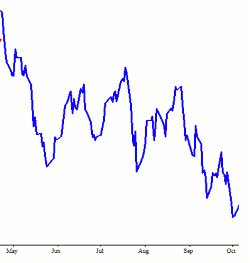Although the second year of a four-year Presidential cycle has historically resulted in market declines, David Moenning of StateoftheMarkets.com points out that the lesser-known eight-year cycle says otherwise.
Raise your hand if you find yourself longing for the good 'ol days of 2013 right about now. You remember, right? The days when stocks marched merrily higher on the back of an improving economy, record earnings, and a Fed that was about as friendly as they have ever been. The days when QE-infinity both here and in the Land of the Rising Sun meant free money for those that could pull off the "carry trade." And the days when the grass definitely looked greener on the other side of the economic fence.
Unfortunately, those days are apparently over. Unfortunately, reality has set in and a lot of folks think that stocks got ahead of themselves in 2013. Unfortunately, all good things (specifically QE and the Fed's ZIRP) must come to an end. And unfortunately, while no one really expected the heady gains of 2013 to continue unabated, admit it; you were secretly hoping they would.
No, in 2014 investors are focused on the idea that this bull market is aging, that the central bankers of the world will have to stop the printing presses at some point, and that growth rates around the globe just aren't as strong as they have been in the past.
Oh, and then there is the fact that the second years of the Presidential cycle have been pretty darned crummy. Ughh.
The Presidential Cycle Says Beware
Don't look now fans, but it's almost that time of year again. Yep, that's right; there are just six more trading days before the month of May begins. And in short, this means that there are just six more trading days before the "Sell in May and Go Away" season officially commences.
Lest you've forgotten, until last year, selling in or around May 1 each year had been a very profitable strategy for many, many years. And given that this year is year number two in the Presidential cycle, a great many analysts have been looking for this trade to be effective once again this year.
History shows that in year two of a President's term, the S&P 500 has actually fallen by a median of -1.5%. However, it is during the second and third quarters of these years that things tend to get ugly as meaningful corrections have had a nasty habit of appearing.
The Cycle Composite Says Beware
Given that the four-year Presidential Cycle makes up one-third of the cycle composite we use in our work (the other cycles included in the composite are the one-year and the 10-year), it isn't exactly surprising to see the composite pointing primarily down over the coming five months.
In fact, according to the cycle composite, the market should begin going down...wait for it...today. Yep, that's right, the cycles say that the market should peak on April 21 and then move steadily lower-in an annoyingly choppy fashion-until October. Joy.
Below is an image of the cycle projection from April 21 through September:
S&P 500 Cycle Projection: April 21 - October 2, 2014
I know what you're thinking: That surely doesn't look like much fun!
Couple this with the fact that the cycles have been pretty spot-on for several years running and you've got a reason to run out and start buying some vol (VXX), raising some cash, selling some covered calls, or putting on some hedges with an inverse ETF or two (SDS).
But Wait, There's Good News!
However, there is one fact that has been almost entirely overlooked by the media.
You see, while 2014 is indeed year two of the Presidential Cycle, it is also-and this is the good part-the sixth year of the current President's term.
Why should you care about such things, you ask?
Although the occurrences are limited, since JFK's Presidency, which began in 1961, the average return for the S&P 500 in the sixth year of a president's term has been 18.3% (median 14.6%). And last time I checked, +18.3% beats the pants off of a decline of -1.5%.
So, while this bull is growing old and the historical odds would seem to favor the bears for the next few months, there is clearly more than one way to look at history. Here's hoping Ms. Market proves the consensus wrong again in 2014!
By David Moenning of StateoftheMarkets.com






















